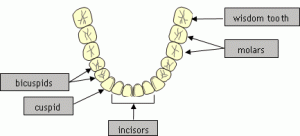Do You Know Your Teeth?
 A lot of us know these white, pearly, bone-like structures as teeth, but how much do you really know about them? Most think teeth are bones and they do hold many of the same properties, however, bones contain sodium and collagen which allows for flexibility and pressure. Therefore, teeth and bones are considered different and treated differently. With bones having that flexibility, it actually gives way to the tooth as being the hardest part of the human body.
A lot of us know these white, pearly, bone-like structures as teeth, but how much do you really know about them? Most think teeth are bones and they do hold many of the same properties, however, bones contain sodium and collagen which allows for flexibility and pressure. Therefore, teeth and bones are considered different and treated differently. With bones having that flexibility, it actually gives way to the tooth as being the hardest part of the human body.
Fixed on the gum line, the teeth have a root that is embedded into the bone. This root holds the tooth into place with help from the gums. The part of the tooth you can see is known as the crown in which the shape gives definition to its purpose. Your front four, upper and lower, teeth have a sharp, chiseled shape meant for cutting or breaking into the skin of a fruit or vegetable. These teeth are known as your incisors.
Next are pointed teeth in which you have two on top and two on the bottom. These are called your canines or referred to as cuspids which help to tear and grind food. The next two sets on both your top and bottom are called bicuspids or premolars and allow for tearing, crushing, and grinding. You will notice that bicuspids are a blend of your canines (cuspids) and the next set of teeth called your molars. Your molars are where the food is crushed and ground down to the finer pieces of food for swallowing. If you’re lucky enough to have a wide mouth the very last set of teeth on the top and bottom are your wisdom teeth. While they do act as an extra molar, they typically cause dental issues and have to be removed. Their removal, however, does not mean you're not chewing your food any better or worse.
To check on all of your food chopping helpers, simply call or go online for a dental appointment.
